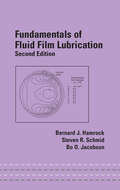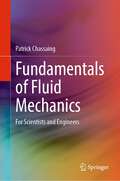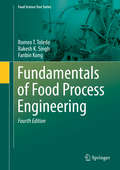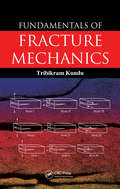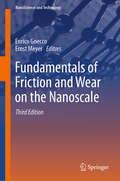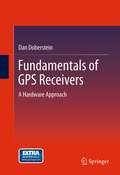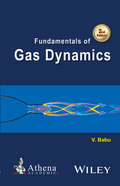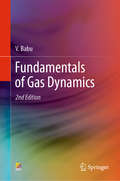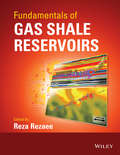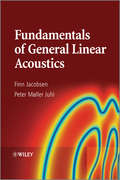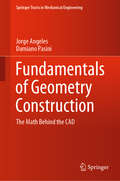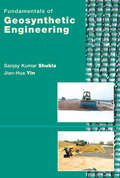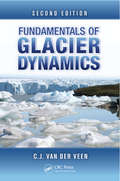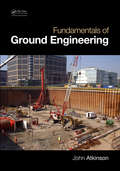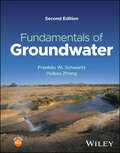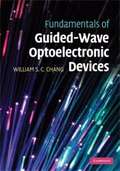- Table View
- List View
Fundamentals of Fluid Film Lubrication (Mechanical Engineering Ser. #Vol. 171)
by Steven R. Schmid Bernard J. Hamrock Bo O. JacobsonSpecifically focusing on fluid film, hydrodynamic, and elastohydrodynamic lubrication, this edition studies the most important principles of fluid film lubrication for the correct design of bearings, gears, and rolling operations, and for the prevention of friction and wear in engineering designs. It explains various theories, procedures, and equations for improved solutions to machining challenges. Providing more than 1120 display equations and an introductory section in each chapter, Fundamentals of Fluid Film Lubrication, Second Edition facilitates the analysis of any machine element that uses fluid film lubrication and strengthens understanding of critical design concepts.
Fundamentals of Fluid Mechanics: For Scientists and Engineers
by Patrick ChassaingThis textbook provides a coherent and structured overview of fluid mechanics, a discipline concerned with many natural phenomena and at the very heart of the most diversified industrial applications and human activities. The balance between phenomenological analysis, physical conceptualization and mathematical formulation serve both as a unifying educational marker and as a methodological guide to the three parts of the work. The thermo-mechanical motion equations of a homogeneous single-phase fluid are established, from which flow models (perfect fluid, viscous) and motion classes (isovolume, barotropic, irrotational, etc.) are derived. Incompressible, potential flows and compressible flows, both in an isentropic evolution and shock, of an ideal inviscid fluid are addressed in the second part. The viscous fluid is the subject of the last one, with the creeping motion regime and the laminar, dynamic and thermal boundary layer. Historical perspectives are included whenever they enrich the understanding of modern concepts. Many examples, chosen for their pedagogical relevance, are dealt with in exercises.The book is intended as a teaching tool for undergraduate students, wishing to acquire a first command of fluid mechanics, as well as graduates in advanced courses and engineers in other fields, concerned with completing what is sometimes a scattered body of knowledge.
Fundamentals of Fluid Power Control
by John WattonThis exciting new reference text is concerned with fluid power control. It is an ideal reference for the practicing engineer and a textbook for advanced courses in fluid power control. In applications in which large forces and/or torques are required, often with a fast response time, oil-hydraulic control systems are essential. They excel in environmentally difficult applications because the drive part can be designed with no electrical components and they almost always have a more competitive power/weight ratio compared to electrically actuated systems. Fluid power systems have the capability to control several parameters, such as pressure, speed, position, and so on, to a high degree of accuracy at high power levels. In practice there are many exciting challenges facing the fluid power engineer, who now must preferably have a broad skill set.
Fundamentals of Food Process Engineering (Food Science Text Series)
by Romeo T. Toledo Rakesh K. Singh Fanbin KongWritten for the upper level undergraduate, this updated book is also a solid reference for the graduate food engineering student and professional. This edition features the addition of sections on freezing, pumps, the use of chemical reaction kinetic date for thermal process optimization, and vacuum belt drying. New sections on accurate temperature measurements, microbiological inactivation curves, inactivation of microorganisms and enzymes, pasteurization, and entrainment are included, as are non-linear curve fitting and processes dependent on fluid film thickness. Other sections have been expanded.
Fundamentals of Foundation Engineering
by Chang-Yu Ou Jianye Ching Kuo-Hsin Yang Fuchen Teng Jiunn-Shyang Chiou Chih-Wei Lu An-Jui Li Jui-Tang LiaoThis book aims to introduce the principle and design of various foundations, covering shallow foundations, mat foundations, earth retaining structures, excavations, pile foundations, and slope stability. Since the analysis and design of a foundation are based on the soil properties under short-term (undrained) or long-term (drained) conditions, the assessment of soil properties from the geotechnical site investigation and the concept of drained or undrained soil properties are discussed in the first two chapters. Foundation elements transfer various load combinations from the superstructure to the underlying soils or rocks. The load transfer mechanisms, vertical stress or earth pressure distributions, and failure modes of each foundation type are clearly explained in this book. After understanding the soil responses subjected to the loadings from the foundation, the design methods, required factors of safety, and improvement measures for each foundation type are elaborated. This book presents both theoretical explication and practical applications for readers to easily comprehend the theoretical background, design methods, and practical applications and considerations. Each chapter provides relevant exercise examples and a problem set for self-practice. The analysis methods introduced in the book can be applied in actual analysis and design as they contain the most up-to-date knowledge of foundation design. This book is suitable for teachers and students to use in foundation engineering courses and engineers who are engaged in foundation design to create a technically sound, construction-feasible, and economical design of the foundation system.
Fundamentals of Fracture Mechanics
by Tribikram KunduAlmost all books available on fracture mechanics cover the majority of topics presented in this book, and often much, much more. While great as references, this makes teaching from them more difficult because the materials are not typically presented in the order that most professors cover them in their lectures and more than half the information p
Fundamentals of Friction and Wear on the Nanoscale
by Enrico Gnecco Ernst MeyerThis book provides an updated review on the development of scanning probe microscopy and related techniques, and the availability of computational techniques not even imaginable a few decades ago. The 36 chapters cover instrumental aspects, theoretical models and selected experimental results, thus offering a broad panoramic view on fundamental issues in nanotribology which are currently being investigated. Compared to the first edition, several topics have been added, including triboluminescence, graphene mechanics, friction and wear in liquid environments, capillary condensation, and multiscale friction modeling. Particular care has been taken to avoid overlaps and guarantee the independence of the chapters. In this way, our book aims to become a key reference on this subject for the next five to ten years to come.
Fundamentals of Friction and Wear on the Nanoscale (NanoScience and Technology)
by Enrico Gnecco Ernst MeyerThis book offers a comprehensive review on the latest developments in the field of nanotribology. With contributed chapters covering instrumental aspects, theoretical models, and selected experimental results, this book provides a broad overview of the fundamental issues currently being investigated in the field. The updated third edition includes new topics such as molecular tribology, multiscale structural lubricity, tribofilm growth, nanoscale friction in liquids, and nanotribology at insect-plant interfaces. Written by a highly qualified group of international experts, this book aims to be a key reference on the subject for the next five to ten years, highlighting the importance of understanding the atomistic origins of friction and wear in everyday life and in technical applications.
Fundamentals of GPS Receivers
by Dan DobersteinFundamentals of GPS receivers covers GPS receivers' theory and practice. The book begins with the basics of GPS receivers and moves onward to more advanced material. The book examines three types of GPS receiver implementations: first is the custom design by the author; second is an industry standard design, now part of the open source network; the third relates to the receiver designed by JPL /NASA. Each receiver is unique allowing the reader to see how each design solves the same problems. Chapters discuss carrier phase measurements and GPS time and frequency measurements. The overall text is measurement oriented as opposed to processing the measurements. With a focus on the fundamentals of measurements the reader will be building their intuition for the physical phenomenon at work.
Fundamentals of Gas Dynamics
by Mrinal KaushikThis textbook for courses in gas dynamics will be of interest to students and teachers in aerospace and mechanical engineering disciplines. It provides an in-depth explanation of compressible flows and ties together various concepts to build an understanding of the fundamentals of gas dynamics. The book is written in an easy to understand manner, with pedagogical aids such as chapter overviews, summaries, and descriptive and objective questions to help students evaluate their progress. The book contains example problems as well as end-of-chapter exercises. Detailed bibliographies are included at the end of each chapter to provide students with further resources. The book can be used as a core text in engineering coursework and also in professional development courses.
Fundamentals of Gas Dynamics
by Oscar Biblarz Robert D. ZuckerNew edition of the popular textbook, comprehensively updated throughout and now includes a new dedicated website for gas dynamic calculations The thoroughly revised and updated third edition of Fundamentals of Gas Dynamics maintains the focus on gas flows below hypersonic. This targeted approach provides a cohesive and rigorous examination of most practical engineering problems in this gas dynamics flow regime. The conventional one-dimensional flow approach together with the role of temperature-entropy diagrams are highlighted throughout. The authors—noted experts in the field—include a modern computational aid, illustrative charts and tables, and myriad examples of varying degrees of difficulty to aid in the understanding of the material presented. The updated edition of Fundamentals of Gas Dynamics includes new sections on the shock tube, the aerospike nozzle, and the gas dynamic laser. The book contains all equations, tables, and charts necessary to work the problems and exercises in each chapter. This book’s accessible but rigorous style: Offers a comprehensively updated edition that includes new problems and examples Covers fundamentals of gas flows targeting those below hypersonic Presents the one-dimensional flow approach and highlights the role of temperature-entropy diagrams Contains new sections that examine the shock tube, the aerospike nozzle, the gas dynamic laser, and an expanded coverage of rocket propulsion Explores applications of gas dynamics to aircraft and rocket engines Includes behavioral objectives, summaries, and check tests to aid with learning Written for students in mechanical and aerospace engineering and professionals and researchers in the field, the third edition of Fundamentals of Gas Dynamics has been updated to include recent developments in the field and retains all its learning aids.
Fundamentals of Gas Dynamics
by V. BabuFundamentals of Gas Dynamics, Second Edition isa comprehensively updated new edition and now includes a chapter on the gas dynamics of steam. It covers the fundamental concepts and governing equations of different flows, and includes end of chapter exercises based on the practical applications. A number of useful tables on the thermodynamic properties of steam are also included.Fundamentals of Gas Dynamics, Second Edition begins with an introduction to compressible and incompressible flows before covering the fundamentals of one dimensional flows and normal shock waves. Flows with heat addition and friction are then covered, and quasi one dimensional flows and oblique shock waves are discussed. Finally the prandtl meyer flow and the flow of steam through nozzles are considered.
Fundamentals of Gas Dynamics (Ane/athena Bks.)
by V. BabuThis textbook on Fundamentals of Gas Dynamics will help students with a background in mechanical and/or aerospace engineering and practicing engineers working in the areas of aerospace propulsion and gas dynamics by providing a rigorous examination of most practical engineering problems. The book focuses both on the basics and more complex topics such as quasi one dimensional flows, oblique shock waves, Prandtl Meyer flow, flow of steam through nozzles, etc. End of chapter problems, solved illustrations and exercise problems are presented throughout the book to augment learning.^
Fundamentals of Gas Shale Reservoirs
by Reza RezaeeProvides comprehensive information about the key exploration, development and optimization concepts required for gas shale reservoirs Includes statistics about gas shale resources and countries that have shale gas potential Addresses the challenges that oil and gas industries may confront for gas shale reservoir exploration and development Introduces petrophysical analysis, rock physics, geomechanics and passive seismic methods for gas shale plays Details shale gas environmental issues and challenges, economic consideration for gas shale reservoirs Includes case studies of major producing gas shale formations
Fundamentals of General Linear Acoustics
by Finn Jacobsen Peter Moller JuhlAcoustics deals with the production, control, transmission, reception, and effects of sound. Owing to acoustics being an interdisciplinary field, this book is intended to be equally accessible to readers from a range of backgrounds including electrical engineering, physics and mechanical engineering. This book introduces the fundamentals of acoustic wave motion. It addresses in a clear and systematic way some of the most difficult parts of acoustics for beginners, such as the widely different approximations due to the wide frequency range, the apparently arbitrary choice between the use of analytical solutions to the wave equation with boundary conditions, and the fundamentally different energy-based considerations used in noise control. As a result, it provides readers with a self-contained source of information on acoustics which can be used for self-study or as a graduate course text. Key features: Places an emphasis on detailed derivations based on the fundamental laws of physics and interpretations of the resulting formulas. Avoids, where possible, electrical and mechanical equivalent circuits, so as to make it accessible to readers with different backgrounds. Introduces duct acoustics, sound in enclosures, and sound radiation and scattering. Contains a set of appendices which includes material on signal analysis and processing as these tools are essential for the modern acoustician.
Fundamentals of Geometry Construction: The Math Behind the CAD (Springer Tracts in Mechanical Engineering)
by Jorge Angeles Damiano PasiniThe textbook provides both beginner and experienced CAD users with the math behind the CAD. The geometry tools introduced here help the reader exploit commercial CAD software to its fullest extent. In fact, the book enables the reader to go beyond what CAD software packages offer in their menus. Chapter 1 summarizes the basic Linear and Vector Algebra pertinent to vectors in 3D, with some novelties: the 2D form of the vector product and the manipulation of “larger" matrices and vectors by means of block-partitioning of larger arrays. In chapter 2 the relations among points, lines and curves in the plane are revised accordingly; the difference between curves representing functions and their geometric counterparts is emphasized. Geometric objects in 3D, namely, points, planes, lines and surfaces are the subject of chapter 3; of the latter, only quadrics are studied, to keep the discussion at an elementary level, but the interested reader is guided to the literature on splines. The concept of affine transformations, at the core of CAD software, is introduced in chapter 4, which includes applications of these transformations to the synthesis of curves and surfaces that would be extremely cumbersome to produce otherwise. The book, catering to various disciplines such as engineering, graphic design, animation and architecture, is kept discipline-independent, while including examples of interest to the various disciplines. Furthermore, the book can be an invaluable complement to undergraduate lectures on CAD.
Fundamentals of Geomorphology (Routledge Fundamentals of Physical Geography)
by Richard Huggett Emma ShuttleworthThis revised and updated edition continues to provide a comprehensive introduction to the subject, exploring the world’s landforms from a broad systems perspective. It covers the basics of Earth surface forms and processes, while reflecting on the latest developments in the field. Fundamentals of Geomorphology begins with a consideration of the nature of geomorphology, including its relation to society, process and form, history, and geomorphic systems, and moves on to discuss: • Structure: structural landforms associated with plate tectonics and those associated with volcanoes, and folds, faults, and joints. • Process and form: landforms resulting from, or influenced by, the exogenic agencies of weathering, running water, flowing ice and meltwater, ground ice and frost, the wind, and the sea; landforms developed on limestone; extraterrestrial landforms; and landscape evolution, a discussion of ancient landforms. Fundamentals of Geomorphology provides a stimulating and innovative perspective on the key topics and debates within the field of geomorphology. Written in an accessible and lively manner, it includes guides to further reading, chapter summaries, and an extensive glossary of key terms. The book is also illustrated throughout with over 200 informative diagrams and attractive photographs, all in colour. It is supported by online resources for students and instructors.
Fundamentals of Geosynthetic Engineering
by Sanjay Kumar Shukla Jian-Hua YinThe development of polymeric materials in the form of geosynthetics has brought major changes to the area of Civil Engineering. Increasing interest in these materials and their use has resulted in significant advances in their practical applications in the last few decades. Following this progress, geosynthetics have become a common and favoured co
Fundamentals of Geotechnical Engineering
by Nagaratnam Sivakugan Braja DasFUNDAMENTALS OF GEOTECHNICAL ENGINEERING, 5E offers a powerful combination of essential components from Braja Das' market-leading books: PRINCIPLES OF GEOTECHNICAL ENGINEERING and PRINCIPLES OF FOUNDATION ENGINEERING in one cohesive book. This unique, concise geotechnical engineering book focuses on the fundamental concepts of both soil mechanics and foundation engineering without the distraction of excessive details or cumbersome alternatives. A wealth of worked-out, step-by-step examples and valuable figures help readers master key concepts and strengthen essential problem solving skills. Prestigious authors Das and Sivakugan maintain the careful balance of today's most current research and practical field applications in a proven approach that has made Das' books leaders in the field.
Fundamentals of Geothermal Heat Pump Systems: Design and Application
by Louis LamarcheFundamentals of Geothermal Heat Pump Systems: Design and Application is written for upper-level undergraduate and graduate courses in renewable energy and heat transfer. This classroom-tested text covers ground heat exchanger modeling, secondary loop ground-source system design, pumping energy, thermal response testing, commercial building applications, and horizontal and groundwater ground heat exchangers. The book is oriented to practical applications, including the economic analysis of ground source heat pump (GSHP) systems, but more theoretical sections are provided covering research-related geothermal applications. Chapters on heat transfer fundamentals and heat pump concepts are included for readers less familiar with thermal engineering concepts. A chapter covering the economic analysis of GSHP systems is also included. All of the examples and problems in the book are solved using the open-source Python programming language.The book will provide students in geothermal energy courses with a solid understanding of the subject. It will also be a valuable reference for professionals working in the field of renewable energy.
Fundamentals of Glacier Dynamics
by C.J. van der VeenMeasuring, monitoring, and modeling technologies and methods changed the field of glaciology significantly in the 14 years since the publication of the first edition of Fundamentals of Glacier Dynamics. Designed to help readers achieve the basic level of understanding required to describe and model the flow and dynamics of glaciers, this second edi
Fundamentals of Ground Engineering
by John AtkinsonFundamentals of Ground Engineering is an unconventional study guide that serves up the key principles, theories, definitions, and analyses of geotechnical engineering in bite-sized pieces. This book contains brief-one or two pages per topic-snippets of information covering the geotechnical engineering component of a typical undergraduate course in
Fundamentals of Ground Improvement Engineering
by David Elton Jeffrey Evans Daniel RuffingGround improvement has been one of the most dynamic and rapidly evolving areas of geotechnical engineering and construction over the past 40 years. The need to develop sites with marginal soils has made ground improvement an increasingly important core component of geotechnical engineering curricula. Fundamentals of Ground Improvement Engineering addresses the most effective and latest cutting-edge techniques for ground improvement. Key ground improvement methods are introduced that provide readers with a thorough understanding of the theory, design principles, and construction approaches that underpin each method. Major topics are compaction, permeation grouting, vibratory methods, soil mixing, stabilization and solidification, cutoff walls, dewatering, consolidation, geosynthetics, jet grouting, ground freezing, compaction grouting, and earth retention. The book is ideal for undergraduate and graduate-level university students, as well as practitioners seeking fundamental background in these techniques. The numerous problems, with worked examples, photographs, schematics, charts and graphs make it an excellent reference and teaching tool.
Fundamentals of Groundwater
by Franklin W. Schwartz Hubao ZhangFundamentals of Groundwater A thoroughly updated classic on the fundamentals of groundwater The second edition of Fundamentals of Groundwater delivers an expert discussion of the fundamentals of groundwater in the hydrologic cycle and applications to contemporary problems in hydrogeology. The theme of the book is groundwater, broadly defined, and it covers the theory and practice of groundwater—from basic principles of physical and chemical hydrogeology to their application in traditional and emerging areas of practice. This new edition contains extensive revisions, including new discussions of human impacts on aquifers, and strategies and concepts for sustainable development of groundwater. It also covers the theory of groundwater flow—including concepts of hydraulic head and the Darcy equation—and ground water/surface water interactions, as well as geochemistry and contamination. Readers will also find A thorough introduction to the techniques of water resource investigations and regional groundwater flow Comprehensive explorations of groundwater chemistry and its applications in regional characterization and assessments of health impacts Practical discussions of groundwater contamination and water sustainability more generally Fulsome treatments of newly emerged contaminants, like PFAS, pathogens, agricultural contaminants, methane, arsenic, uranium, and redox processes Perfect for undergraduate and graduate students taking courses in hydrogeology, groundwater, geoscience, applied geoscience, and groundwater and contaminant processes, Fundamentals of Groundwater also benefits environmental consultants, geochemists, engineers, and geologists.
Fundamentals of Guided-Wave Optoelectronic Devices
by William S. C. ChangOptoelectronic guided-wave devices are used in a wide range of optical fiber communication and optoelectronic systems. In such networks, the electrical and the optical characteristics of guided-wave devices, and the interplay between them, have a profound effect on system design and overall performance. Uniquely, this book combines both the optical and electrical behavior of guided-wave optoelectronic devices so that the interwoven properties, including interconnections to external components, are easily understood. It provides the key concepts and analytical techniques that readers can apply to current and future devices. It also presents the impact of material properties on guided-wave devices, and emphasizes the importance of time-dependent interactions between electrical and optical signals. This is an ideal reference for graduate students and researchers in electrical engineering and applied physics departments, as well as practitioners in the optoelectronics industry.
